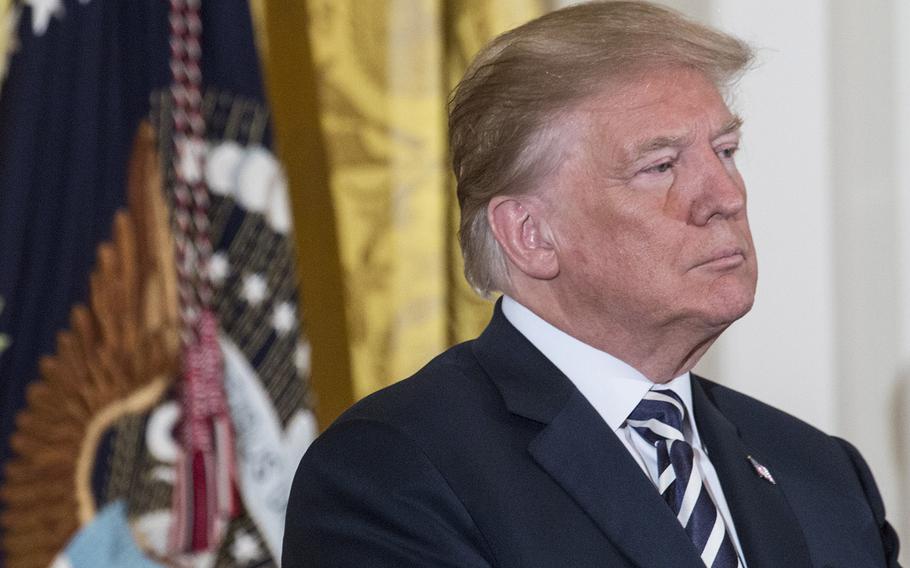
President Donald Trump at a White House ceremony in May, 2018. (Stars and Stripes)
WASHINGTON – President Donald Trump is using recent changes at the Department of Veterans Affairs as a blueprint to make it easier to fire employees across the federal government.
Trump signed three executive orders Friday afternoon that aim to limit union activity, shorten the amount of time it takes to fire federal workers and encourage agencies to fire employees, instead of merely disciplining them.
“It’s fulfilling a promise to empower every Cabinet secretary to remove those who undermine the public trust or fail the American people,” Andrew Bremberg, director of the Domestic Policy Council and an assistant to the president, said while announcing the changes Friday.
The gist of the orders is to weed out bad workers – the same driving force behind changes made at the VA last June.
The VA Accountability and Whistleblower Protection Act of 2017 created more repercussions and a quicker firing process for poor-performing VA employees. Advocates saw it as a way to root out a perceived culture of corruption at the VA, which has been rocked by scandals in recent years.
The bill cut an advance-notice period given to employees ahead of their termination from 30 days to 10 days. It also sped up the process that employees use to appeal any disciplinary action against them. It lessened the evidentiary standards required to fire an employee, and it allows the VA secretary to recoup bonuses and relocation expenses in certain instances.
Since it was implemented in June, the number of firings increased. The VA fired 1,484 of its 370,000-person workforce last year, according to publicly posted data. In the first quarter of 2018, 714 people have been fired from the VA.
During his State of the Union address in January, Trump made clear he wanted to extend the changes made at the VA throughout the federal government. He urged Congress to pass legislation giving every Cabinet secretary “the authority to reward good workers and to remove federal employees who undermine the public trust or fail the American people.”
“We worked closely with the veterans department as they implemented accountability – that’s the source of the president’s call in the State of the Union,” said a senior administration official who would not speak on the record.
The orders Trump signed Friday aren’t as extensive as the changes made at the VA, but they’re as much as Trump can do within his power, the administration official said. The White House will continue to call on Congress to rewrite civil-service laws.
“This is everything the executive branch can do in pursuit of this goal,” the official said. “It doesn’t get as far as the VA Accountability Act did for the veterans department. The key difference is that [the VA Accountability Act] is permanent law that can’t be changed by an administration change.”
However, the orders go further than the VA Accountability Act to address employees’ union activity.
Trump directed agencies to renegotiate union contracts, with the goal of cutting time employees spend on union business by two-thirds. In a fact-sheet distributed by the White House, the administration used the VA as an example of employees using too much time on union work.
It’s not the first instance the issue has been raised.
The Government Accountability Office reported 346 VA workers spent 100 percent of their work time as union representatives in 2015. The White House fact sheet Friday claimed that 470 employees now spend all of their work time on union activities.
House Republicans blasted the VA last spring for allowing it, and Rep. Jodey Arrington, R-Texas, introduced legislation to prohibit VA employees to spend more than 50 percent of their official time on union work.
The American Federation of Government Employees pushed back. The AFGE is a federal union representing approximately 220,000 VA workers. Its president, J. David Cox Sr., argued at the time that hours spent on union activities helped to improve VA workplaces, which in turn led to improved services for veterans.
“The very right of federal employees to join and be represented by their unions seems to be in question,” Cox said at the time.
One of the orders Trump signed Friday cuts the amount of work time employees can spend on union business to 25 percent. The order also requires agencies to charge rent to employees who use federal office space for union activities and to stop paying their travel expenses.
In addition, agencies must now report terminations and disciplinary actions to the Office of Personnel Management, which will publicize them. The action is an attempt to eliminate instances of employees getting fired or disciplined at one department and then hired by another federal agency that was unaware of past poor performance.
The White House posited the executive orders as a good thing for taxpayers and well-performing federal workers.
The changes would save “at least $100 million a year” the fact sheet states, though it doesn’t go into detail on how the administration arrived at that number.
“This executive order is about promoting better use of taxpayer dollars and helping support hundreds of thousands of civil servants who come to work every day to do a great job to serve their country,” the unnamed official said.
Wentling.nikki@stripes.com Twitter: @nikkiwentling